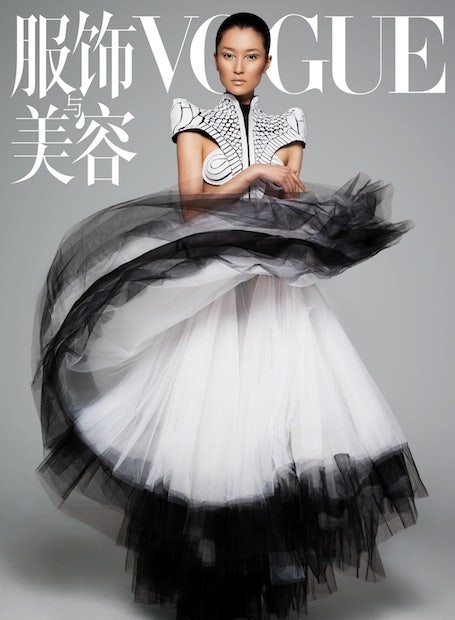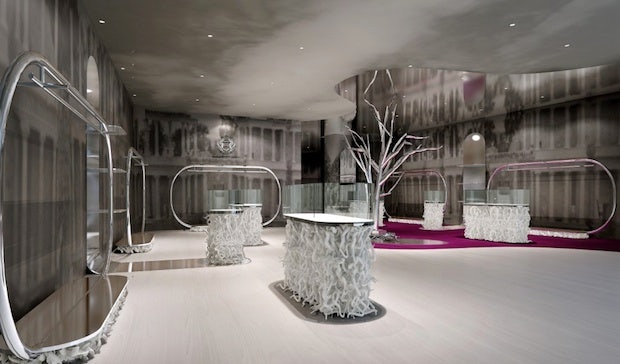Winner Of China's Answer To Project Runway Talks Design And Branding With Jing Daily#

Designer Chico Wang with his winning designs on Creative Sky.
Three years ago,
Chico Wang#
was a successful visual merchandiser at Lane Crawford, where he designed the visual displays for top global designers such as Alexander McQueen, Christian Dior, and Yves Saint Laurent. However, Wang, who has a degree from the Beijing Institute of Fashion Technology, decided he wanted to someday be one of the designers of the clothing for which he was designing displays. In 2011, he took a chance and went on China's version of Project Runway, a show called Creative Sky (创意星空).
This bet paid off, because Chico prevailed as the show's ultimate champion. He now resides in New York City, where he is studying fashion design at Parsons with a scholarship that was part of his prize. Jing Daily recently sat down with him for an interview about what his backgrounds in both design and marketing have taught him about selling couture to Chinese clients.
What made you want to participate in Creative Sky and what was your expectation from it?#
After working as a visual merchandiser for years at an international platform like Lane Crawford, I turned from a novice to a professional designer with a critical eye. I became very familiar with the fashion industry and I wanted to be back on track as a fashion designer. I thought Creative Sky was a great opportunity for me to make this transition and the chance it provided to study at Parsons was just fabulous. I never thought about winning first prize, but it was a pleasant moment.
Where did your passion for fashion design come from?#
When I was very young, I enjoyed making clothes for my Barbie dolls and I took any textiles I could find -- tablecloths, curtains, my mother’s aprons, and my father’s socks -- to make those clothes. I never realized that fashion design, either as a profession or as an industry, existed before going to secondary school, but as soon as I heard about this existence, I decided to become part of it without a minute for doubt or hesitance.
How would you describe your design aesthetic?#
My design is dramatic, exuberant, vibrant, and refined. I love experimenting with the structure of clothing and I love colorful design -- color makes people happy.
What are the major differences between the fashion design practice in China and that of the United States, or more precisely, New York City?#
You can’t simply make a comparison between China and the United States. There is no better or worse between them. China’s fashion practice is at a different development stage and I think a more appropriate way to conceptualize this question is to say that the design practice in China has a different timeframe from that of the United States.

Chico Wang's design on the cover of China's December 2011 issue of Vogue.
What is you long-term goal?#
My long-term goal is to work at a major fashion brand as a creative designer, and eventually, I wish I could establish my eponymous brand.
Who were your major clients while working at Lane Crawford?#
Except from preparing for Lane Crawford’s seasonal window displays, I completed visual projects for a variety of brands’ shop-in-shops. Alexander McQueen, YSL, Balenciaga, Miu Miu, Dries Van Noten, Christian Louboutin, Marni, Phillip Lim, Christian Dior, Burberry, and Raf Simons... just to name a few.
Were there any projects that made you especially proud of yourself?#
Not really. I have never felt completely satisfied with any of my projects because I always think I could have done better, if given more time or a bigger budget.
Let's talk about visual merchandising for Chinese consumers. How important is it in the luxury retail experience, both on the mainland and abroad? In your experience, do Chinese consumers look for and respond to different visual presentations than Western consumers?#
The visual merchandising standards of leading luxury brands are identical, regardless of the location, but Chinese customers are still on their way to trained as great connoisseurs, compared to their European or American peers.
Visual merchandising is essential for Chinese customers’ positioning of the brand and thus their decision making of purchase. Chinese customers don’t know very well about a brand’s history or heritage, so they try to judge, or evaluate a brand through its visual displays. Local Chinese brands start to understand the importance of visual merchandising in terms of its ability to define and express a brand’s identity. Visual merchandising is in fact visual expression of a brand’s identity. It can be vibrant, thus attractive to curious Chinese shoppers, but it won’t change the essence of the brand’s core identity.

Wang is also a talented designer of store displays. Above is a design he did for Italian luxury brand PTG.
In your experience, what are the most important elements to keep in mind when designing visual merchandising for upscale Chinese consumers? Do you have any advice for Western luxury retailers looking to better serve Chinese customers through their visual merchandising?#
I would say, as a visual merchandiser, knowing about the brand and its customers is the most important thing to keep in mind. I always spend a substantial amount of time to know about the brand and to discuss every detail with the brand’s managers before moving on to start the design process. Understanding the brand itself, as well understanding what the brand’s customers expect to see, is the key to a successful visual project.
While you've been in New York, have you seen visual displays that you think are particularly well-suited to attract Chinese clientele? Tell us about them.#
Not really. I don't think American brands care too much about visual merchandising, in contrast, Chinese brands use visual displays to attract customers and therefore they offer better budgets.